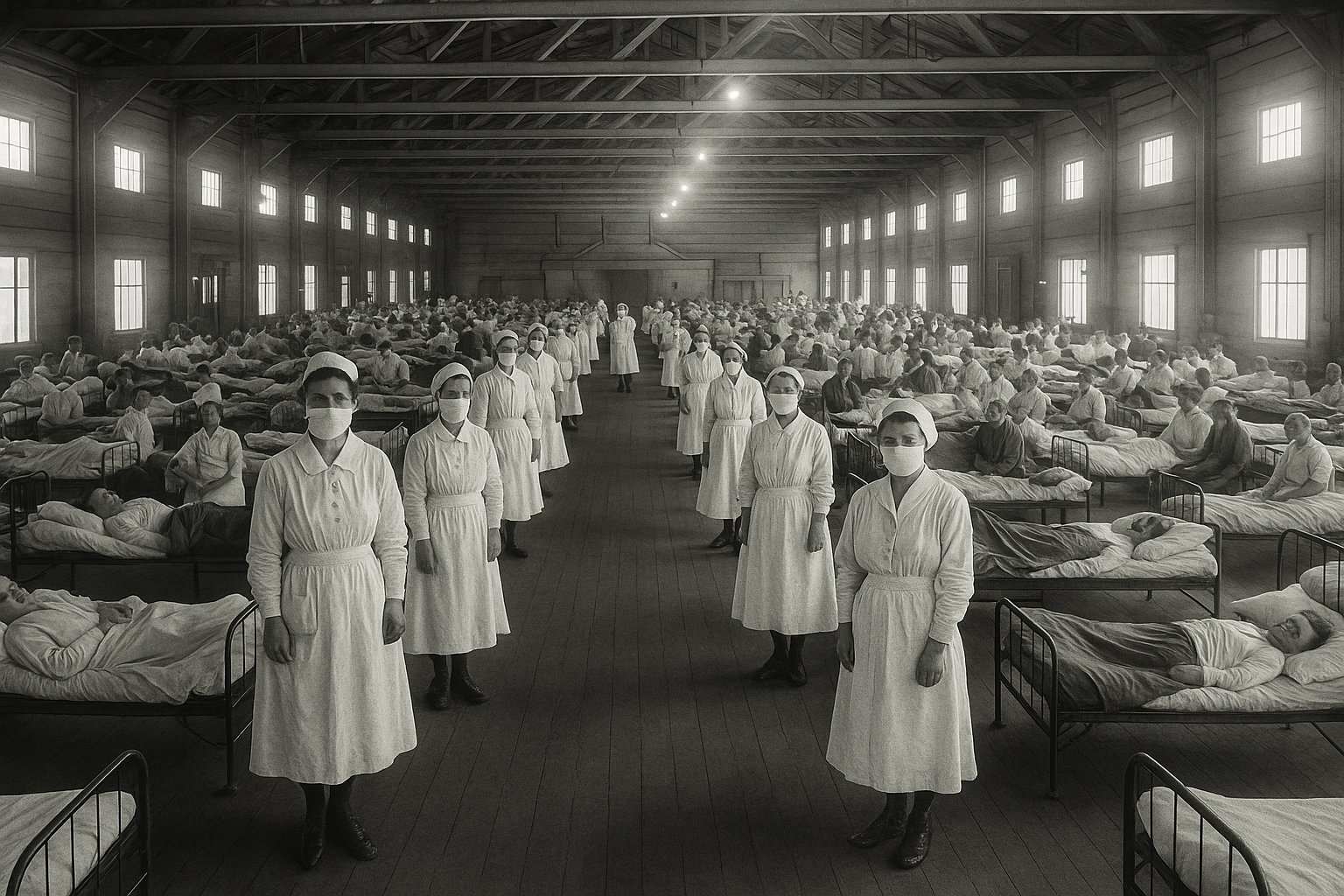Introduction: The Ghost of a Pandemic Past
In 1918, as the Great War entered its final, bloody chapter, a new, invisible enemy emerged. It moved with the silent efficiency of a phantom, hitching rides on troopships and trains, circling the globe in just four months. This was the H1N1 influenza A virus, infamously known as the “Spanish Flu.” It was a plague of unprecedented scale, infecting an estimated 500 million people—a third of the world’s population at the time—and killing between 50 and 100 million. The death toll dwarfed that of World War I, and in the United States alone, the pandemic claimed 675,000 lives, causing the average life expectancy to drop by 12 years in a single, terrifying year.
This pandemic was not just defined by its staggering mortality, but by its baffling and cruel paradox: its primary targets were not the usual victims of influenza—the very young and the very old—but healthy adults in the prime of their lives. The typical U-shaped mortality curve of infectious disease was grotesquely twisted into a “W,” with a terrifying new peak among those aged 20 to 40. Young, robust soldiers who had survived the trenches succumbed in crowded barracks; pregnant women died in disproportionate numbers, leaving a generation of orphans. This central mystery—why the strongest immune systems were the most vulnerable—haunted medicine for nearly a century. The virus itself vanished after 1920, leaving behind a legacy of terror but no living samples for study. To solve the mystery, scientists would have to embark on a quest that sounded like science fiction: they would have to find the ghost of the 1918 virus, piece together its genetic code, and bring it back to life.
The profound trauma of the pandemic was so swift and widespread that it was largely suppressed from cultural memory. Despite its impact far exceeding that of the war, the “Great Influenza” became what historian Alfred W. Crosby and virologist Jeffery Taubenberger have called a “forgotten pandemic”. Major literary figures of the “lost generation,” whose work was defined by the war, barely mentioned the plague that had killed orders of magnitude more people. Unlike a war with clear enemies and heroic narratives, the pandemic was an indiscriminate, invisible force that left behind only silence and a deep-seated societal fear. This cultural amnesia meant that the urgent scientific questions about its unique lethality remained unanswered for decades. The resurrection of the virus was therefore not just a scientific endeavor; it was an act of historical reclamation, forcing a modern world to confront a threat it had long tried to forget and to finally understand the secrets of its deadliest killer.
An Arctic Hunt for a Microscopic Killer
The Challenge of Finding the Virus
The quest to understand the 1918 virus faced a fundamental obstacle: influenza is an RNA virus. Unlike the robust double helix of DNA, RNA is a single-stranded molecule that is notoriously fragile and degrades rapidly after its host dies. For decades, the virus was considered extinct, with no live isolates available for study. The only hope of ever understanding its genetic secrets lay in finding preserved fragments of its RNA in the tissues of its long-dead victims—a task akin to finding a few specific grains of sand on a vast beach.
The Pioneer: Dr. Jeffery Taubenberger’s “Crazy Idea”
The first major breakthrough came from the laboratory of Dr. Jeffery Taubenberger at the Armed Forces Institute of Pathology (AFIP). Taubenberger was a specialist in molecular pathology, pioneering techniques to extract and analyze degraded nucleic acids from tissues that had been fixed in formaldehyde and embedded in paraffin wax for preservation—a process that was widely believed to destroy fragile RNA. In what he later called a “crazy idea,” Taubenberger wondered if these advanced methods could be used to find the ghost of the 1918 virus within the AFIP’s vast collection of historical tissue samples.
Using a highly sensitive technique called reverse transcription-polymerase chain reaction (RT-PCR), his team began the painstaking work of searching for viral genetic fragments. In 1997, they announced a landmark success: they had recovered and sequenced nine fragments of viral RNA from the(https://archive.cdc.gov/www_cdc_gov/flu/pandemic-resources/reconstruction-1918-virus.html), a 21-year-old U.S. soldier who had died at Camp Jackson, South Carolina, on September 26, 1918. It was the first time scientists had laid eyes on the genetic code of the 1918 killer. However, the RNA from these paraffin-embedded samples was extremely fragmented, with pieces no larger than 120 base pairs, making the prospect of sequencing the entire 13,500-base-pair genome a near-impossible task.
The Breakthrough in the Permafrost
The solution to this puzzle came not from a high-tech laboratory but from the dogged persistence of a retired pathologist named Dr. Johan Hultin. In 1951, as a young microbiologist, Hultin had traveled to a remote Inuit village called Brevig Mission, Alaska, which had lost 85% of its adult population to the flu in a single week in November 1918. With permission from the village elders, he exhumed a mass grave, hoping to culture the live virus from the frozen lungs of the victims. The attempt failed.
For nearly 50 years, the mystery remained unsolved. Then, in 1997, Hultin, now 72 years old, read Taubenberger’s paper describing the successful recovery of RNA fragments. Realizing that modern technology could succeed where he had failed, Hultin contacted Taubenberger and, at his own expense, returned to Brevig Mission. This time, he exhumed the body of an Inuit woman—whom he later nicknamed “Lucy”—who had been buried deep in the permafrost. Her obesity had insulated her internal organs, and the subzero ground had acted as a perfect natural freezer for nearly 80 years, preserving her lung tissue and, crucially, the viral RNA within it. Hultin carefully excised the lungs, placed them in preserving fluid, and shipped them to Taubenberger’s team. This single act of scientific dedication provided the high-quality, less-fragmented genetic material that was the final key to unlocking the full genome of the 1918 virus.
The successful sequencing of the virus was not the result of a single, linear project but a remarkable convergence of disparate elements. Without Taubenberger’s team developing novel molecular techniques, the genetic material in Hultin’s sample would have been unusable, just as it was in 1951. Without Hultin’s lifelong persistence and his decisive action upon reading of Taubenberger’s work, the research would have stalled, limited by the severely degraded RNA from the archived soldier tissues. And without the serendipitous natural preservation of “Lucy” in the Alaskan permafrost, both scientific efforts would have ultimately been in vain. This story highlights that groundbreaking science often relies on a fragile interplay of technological innovation, human passion, and sheer luck.
Rebuilding a Monster in a High-Security Lab
The Science of Resurrection: Reverse Genetics
With the complete genetic blueprint of the 1918 virus finally in hand, the next, most audacious step was to bring it back to life. This was accomplished using a technique known as reverse genetics. In simple terms, scientists synthesized the virus’s eight RNA gene segments in the laboratory based on the sequenced code. These synthetic genes were inserted into circular pieces of DNA called plasmids. When these plasmids were introduced into cultured human kidney cells, the cells’ own machinery read the genetic instructions and began producing all the components of the 1918 virus, which then self-assembled into live, infectious viral particles.
The Chosen One: Dr. Terrence Tumpey and the CDC
The immense responsibility of this reconstruction fell to a single scientist:(https://archive.cdc.gov/www_cdc_gov/flu/pandemic-resources/reconstruction-1918-virus.html), a microbiologist at the Centers for Disease Control and Prevention (CDC) in Atlanta. The decision to limit the work to one individual was a critical safety measure. Dr. Tumpey later recalled his feelings at the time: “I was very excited, and I was very anxious in 2005. When you’re getting ready to remake a virus that is estimated to have killed at least 50 million people worldwide, I was passionate about the great task ahead”.
Decoding the Blueprint: An Avian Virus in Disguise
The full genome sequence confirmed that the 1918 pandemic was caused by an H1N1 influenza A virus. Its genetic signature revealed that it was most likely an
avian virus that adapted to infect humans, seemingly without first reassorting, or mixing its genes, with a pre-existing human flu virus. This was a crucial finding, as it demonstrated that an avian virus could jump directly to humans and cause a devastating pandemic. The analysis identified several key adaptations that made this possible. The virus’s polymerase genes, which are responsible for viral replication, contained a small number of mutations that made them highly efficient in mammalian cells. Furthermore, its hemagglutinin (HA) protein—the molecule on the virus’s surface that binds to host cells—had acquired mutations allowing it to effectively attach to receptors in the human respiratory tract.
The Moment of Creation
In July 2005, after weeks of tense anticipation, Dr. Tumpey observed the telltale signs of viral replication in his cell cultures. The ghost of 1918 was alive again. He sent a simple, historic email to his collaborators, signaling the success of the reconstruction and the beginning of a new, critical phase of research.
Inside a BSL-3E Lab: The Unprecedented Safety Measures
Recreating one of history’s deadliest pathogens required a level of biocontainment far beyond that of a standard laboratory. The work was conducted under(https://archive.cdc.gov/www_cdc_gov/flu/pandemic-resources/reconstruction-1918-virus.html), a stringent set of protocols designed to contain the extraordinarily dangerous virus.
- Personnel: Dr. Terrence Tumpey was the only scientist authorized to handle the live, reconstructed virus. He was required to work alone, often after normal business hours, to minimize risk to his colleagues.
- Protective Gear: Entry into the lab required wearing a full-body suit, double gloves, shoe covers, and a powered air purifying respirator (PAPR), which provides a continuous flow of filtered air to a sealed hood.
- Facility: All experiments were performed inside a Class II biosafety cabinet, which is a sealed, ventilated enclosure. The laboratory itself was built with negative air pressure and controlled, HEPA-filtered airflow, ensuring that no air could escape the facility without being decontaminated.
- Protocols: Dr. Tumpey underwent continuous health monitoring and took a daily prophylactic dose of the antiviral drug oseltamivir. He understood and accepted that if he were to become infected, he would be placed in strict quarantine, completely isolated from the outside world.
- Security: Access to the BSL-3E laboratory was controlled by a biometric fingerprint scanner, and the freezers containing the virus samples were secured by an iris scanner, ensuring only Dr. Tumpey could access them.
A prevailing theory for over a century was that the extreme lethality of the 1918 pandemic was primarily a product of its time—that the conditions of World War I, such as crowded military camps and poor sanitation, combined with the lack of antibiotics to treat secondary bacterial pneumonia, were the main drivers of the high death toll. While these factors undoubtedly exacerbated the crisis, the resurrection of the virus allowed scientists to test its intrinsic virulence in a controlled, modern setting. The results were terrifying. The reconstructed 1918 virus was exceptionally lethal in animal models, including mice, ferrets, and macaques, causing rapid and severe disease without any of the confounding factors of 1918. In one study, mice infected with the 1918 virus had 39,000 times more viral particles in their lungs just four days after infection compared to mice infected with a contemporary flu strain. This demonstrated unequivocally that the virus possessed an inherent, extraordinary pathogenicity that was not solely dependent on its historical context. This finding carries a chilling implication for modern pandemic preparedness: a virus with this level of intrinsic power could emerge again, and it would be devastating even in a world with advanced medical care.
The “Cytokine Storm”: When a Strong Immune System Becomes a Weapon
Explaining the “Cytokine Storm”
The resurrection of the 1918 virus finally allowed scientists to provide a direct, experimental answer to the pandemic’s central paradox: why it was so deadly to the young and healthy. The answer lies in a phenomenon known as a “cytokine storm”. In a normal infection, the immune system releases proteins called cytokines, which act as chemical messengers to coordinate a measured attack against the invading pathogen. A cytokine storm is what happens when this system goes haywire. It can be thought of as the immune system’s panic button, triggering a massive, uncontrolled positive feedback loop. Immune cells release a flood of cytokines, which in turn recruit more immune cells to the site of infection. This overwhelming inflammatory response begins to attack the body’s own tissues, particularly the delicate cells lining the lungs. The result is severe inflammation, fluid buildup in the lungs, acute respiratory distress syndrome (ARDS), and, ultimately, death.
Connecting the Storm to the “W” Curve
The cytokine storm hypothesis provides a compelling explanation for the 1918 pandemic’s W-shaped mortality curve. The healthy young adults who died in such staggering numbers were the victims of their own powerful immune systems. It was this very strength that the virus turned against them, provoking the most severe and lethal cytokine storms. For these individuals, their robust immunity became a fatal liability rather than an asset.
Evidence from the Reconstructed Virus
(https://www.cidrap.umn.edu/avian-influenza-bird-flu/scientists-recreate-1918-flu-virus-see-parallels-h5n1) provided the definitive proof. Animal models infected with the virus showed that it replicated to exceptionally high levels in the lungs with astonishing speed. This massive viral load triggered a dysregulated and hyper-inflammatory immune response. Pathological analysis of the animals’ lungs revealed severe damage consistent with a cytokine storm, mirroring the descriptions from autopsies performed in 1918. This was the first direct experimental evidence confirming that the virus’s lethality was driven by its ability to weaponize the host’s own immune response.
The 1918 virus is not just a brute-force pathogen; it is a sophisticated manipulator of the host’s defenses. Its lethality appears to be a two-step process. First, specific viral genes, such as the non-structural protein 1 (NS1), are highly effective at suppressing the body’s initial antiviral response, particularly the production of interferon. This act of immune evasion allows the virus to replicate unchecked, building up an enormous viral load before the immune system is fully aware of the threat. When the immune system finally does recognize the scale of the infection, it overreacts catastrophically. Instead of a coordinated, targeted response, it launches an all-out, disorganized assault—the cytokine storm. This understanding of the virus’s strategy of immune misdirection has profound implications for modern medicine. It suggests that treating future severe influenza pandemics may require a dual-pronged approach: powerful antiviral drugs to combat the virus itself, combined with immunomodulatory therapies designed to calm the cytokine storm and prevent the immune system from inflicting fatal damage.
Lessons from a Resurrected Virus for a Safer Future
A Benchmark for Modern Threats (H5N1)
The research into the 1918 virus is not merely a historical exercise; it is a critical component of modern pandemic preparedness. Because the 1918 virus was an avian-like virus that successfully adapted to mammals, it serves as the ultimate “worst-case scenario” model for assessing the threat posed by contemporary avian influenza viruses, most notably the highly pathogenic H5N1 strain. Genetic analysis revealed striking similarities between key genes of the 1918 virus, particularly its polymerase complex, and those found in some circulating H5N1 viruses. This knowledge allows scientists to monitor emerging avian flu strains for high-risk genetic signatures that could indicate an increased potential for human adaptation and transmission, providing a crucial early warning system for a potential pandemic.
The Quest for a Universal Flu Vaccine
The study of the 1918 virus has become a cornerstone in the global scientific effort to develop a universal influenza vaccine—a “holy grail” of vaccinology that would provide broad and durable protection against multiple seasonal and pandemic flu strains. Current seasonal flu vaccines primarily target the highly variable “head” of the virus’s hemagglutinin (HA) protein, which is why they must be reformulated every year. Research on the 1918 virus and other strains has illuminated the structure of the HA protein’s “stem,” a region that is much more conserved across different influenza subtypes. This has led to innovative vaccine designs, such as “chimeric HA” vaccines, which combine the conserved stem of a common virus (like H1N1) with the head of a more exotic avian virus. The goal is to train the immune system to produce broadly protective antibodies against the conserved stem, thereby conferring immunity to an entire group of influenza viruses. The National Institute of Allergy and Infectious Diseases (NIAID) explicitly uses the 1918 pandemic as a benchmark in its strategic plan, aiming for a universal vaccine that is at least 75% effective and provides protection for more than a single season.
Informing Public Health and Economic Policy
The experience of 1918 also provides vital lessons in public health policy. Historical analyses have shown that American cities that implemented early and extensive non-pharmaceutical interventions (NPIs)—such as closing schools, banning public gatherings, and enforcing quarantines—not only experienced lower overall mortality rates but also had stronger economic recoveries after the pandemic subsided. This finding directly counters the argument that public health measures inevitably harm the economy and provides a powerful, evidence-based case for swift and decisive action in the face of a new pandemic threat.
The moniker “Mother of all Pandemics” is more than just a dramatic title; it is a genetic reality. Virological research has revealed that all subsequent influenza A pandemics—in 1957, 1968, and 2009—as well as nearly all seasonal flu strains of the last century, are direct descendants of the 1918 H1N1 virus. The 1957 and 1968 pandemic viruses emerged when the circulating descendant of the 1918 virus reassorted, or swapped genes, with new avian flu viruses. The 2009 H1N1 pandemic was caused by a more direct descendant that had been circulating in swine for decades. This means the genetic backbone of the most successful and deadly influenza virus in modern history is still circulating and evolving today. Studying the original 1918 virus is therefore not just an examination of a past threat, but a fundamental investigation into the progenitor of most of the flu viruses we face today, making the resurrection research profoundly and urgently relevant.
Conclusion: Looking Back to Move Forward
The journey to resurrect the 1918 influenza virus is a story of scientific determination against incredible odds. It began with a historical mystery—a devastating plague that vanished—and culminated in a high-stakes, high-security laboratory experiment that brought a killer back to life. This unprecedented effort unlocked the virus’s most guarded secrets: its avian origins, the genetic adaptations that allowed it to thrive in humans, and its terrifying ability to turn a healthy immune system into a weapon of self-destruction through a cytokine storm.
This research inevitably walks an ethical tightrope. The act of recreating an extinct pathogen with pandemic potential falls under the controversial category of “gain-of-function” research, raising valid concerns about biosafety and the risk of accidental release. However, the scientists involved argue that it represents a necessary and calculated risk. As Dr. Taubenberger has noted, it is counterintuitive to argue that a threat that exists in nature is too dangerous to be studied under controlled conditions in a laboratory. The choice is not between risk and safety, but between the manageable risks of controlled research and the profound risk of being unprepared for a naturally emerging pandemic.
The echoes of 1918 serve as a powerful and enduring warning. The world today is more populous and interconnected than ever, creating ideal conditions for the rapid spread of a novel virus. By resurrecting the ghost of the last great pandemic, scientists have armed us with the critical knowledge needed to identify, fight, and potentially prevent the next one. The lessons learned from the resurrected 1918 virus are not historical curiosities; they are active and essential components in our ongoing struggle to ensure that such a global catastrophe is never repeated.












